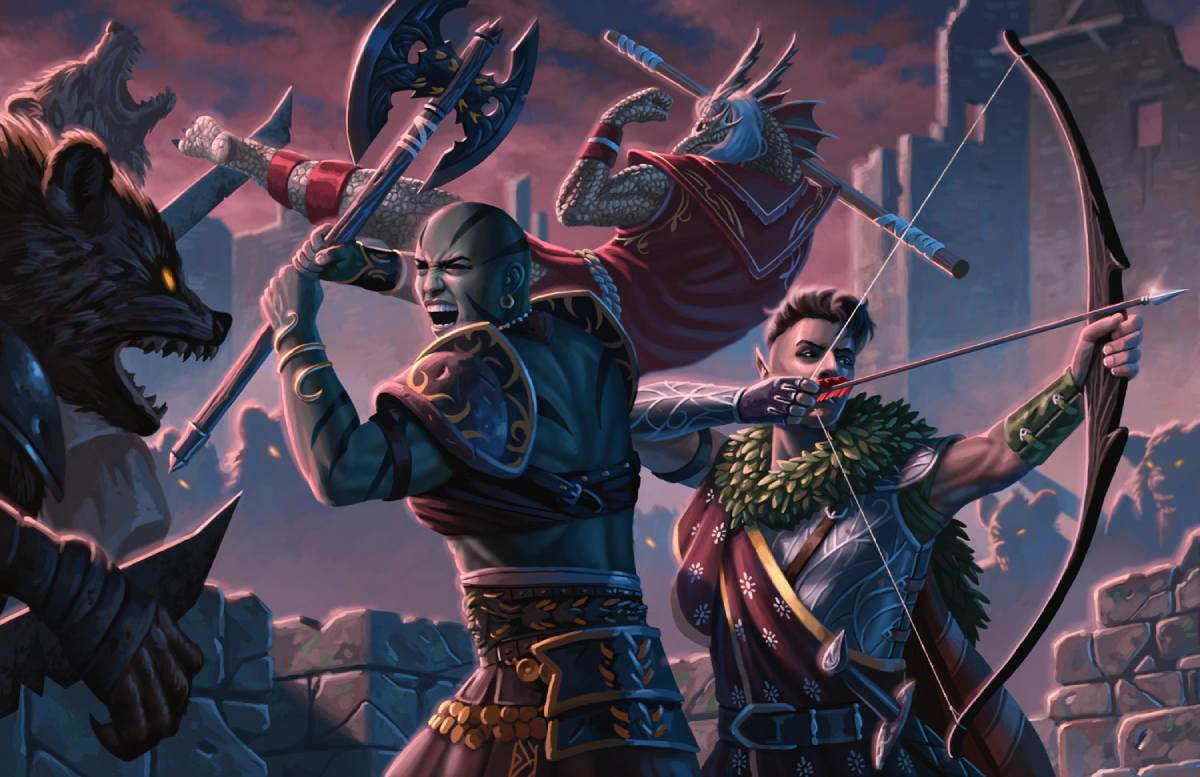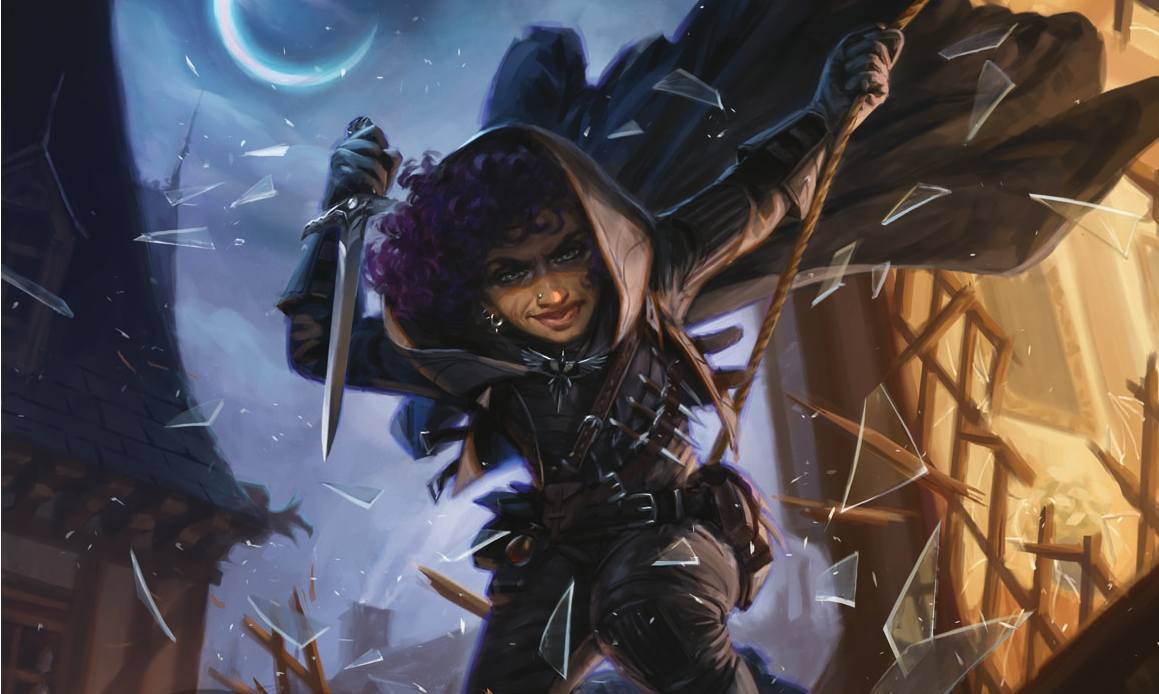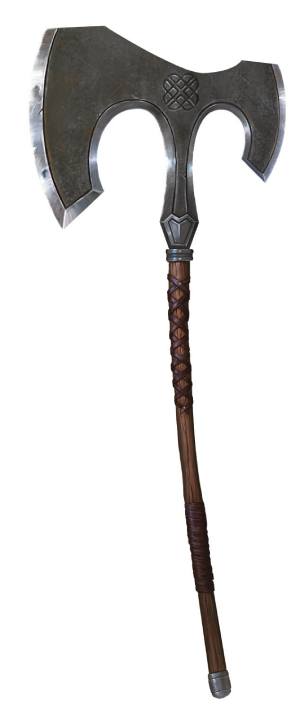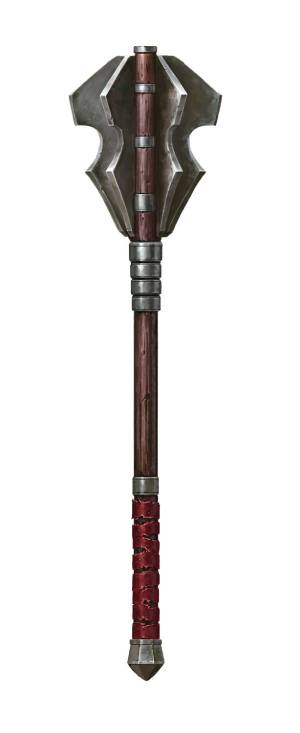The Fighter uses their Maul to knock down their opponent, the Rogue dances around with their Rapier to find their foe’s weak point, and the Barbarian swings a Greataxe through two enemies with a single blow. Every character in D&D has a unique flare they bring to combat, and that’s reflected in the new Weapon Mastery feature in the Player’s Handbook!
Let’s explore these fresh ways to utilize your weapons in the upcoming core rulebook revamp!
Build Your Warrior Today
Start building your weapon-wielding warrior today in D&D Beyond's Character Builder. You can access Weapon Mastery for free using the D&D Beyond Basic Rules, so you can test out this new brand-new system and start cutting a heroic path through your foes!
What is Weapon Mastery?

Weapon Mastery is a class feature shared between some martial classes that reflects their specialization with certain types of weapons.
Each weapon in the Equipment section of the 2024 Player’s Handbook lists a mastery property in addition to the weapon’s regular properties. If the weapon meets the requirements in your class's Weapon Mastery feature, you can learn its mastery property and use it in combat.
But learning a mastery property isn't permanent. If you stumble across a shiny new +1 Longsword and want to learn its mastery properties instead, don’t worry! During a Long Rest, you can practice weapon drills and swap out one of your weapon choices at the end of the rest.
The number of mastery properties you can learn is specified in your class's version of the Weapon Mastery feature. Rogues, rangers, and paladins can only access two mastery properties at a time, whereas barbarians and fighters start with two and three, respectively, and eventually gain access to more mastery properties, as detailed in their Features table.
At level 1, Barbarians, Fighters, Paladins, Rangers, and Rogues get access to the mastery properties for certain types of weapons, as listed below:
- Barbarian: Simple and Martial Melee weapons
- Fighter: Simple and Martial weapons
- Paladin: Based on weapon proficiencies (Simple and Martial weapons)
- Ranger: Based on weapon proficiencies (Simple and Martial weapons)
- Rogue: Based on weapon proficiencies (Simple weapons and Martial weapons with the Finesse or Light property)
Mastering Weapon Mastery
Some subclasses allow you to access more mastery properties. For example, the Soulknife Rogue can use the Vex mastery property with their Psychic Blades and it doesn’t count toward their learned Weapon Mastery limit.
How to Use Weapon Mastery Properties
If you’re wielding a weapon and have learned its mastery property, you’ll be able to use that mastery property every turn when you make an attack with the weapon.
Different mastery properties have different triggers. For example, Cleave requires you to hit a creature with a melee attack roll while Graze triggers when you miss a creature with an attack roll.
Unlike some abilities, there’s no limit to how many times mastery properties can be used per Short or Long Rest, so go nuts!
Mastery Properties Overview

Below, we’ll cover each of the eight mastery properties included in the 2024 Player’s Handbook. We’ll even throw in some tips to help you brainstorm ideas for your new characters!
Cleave

Example Weapon: Greataxe
If you’ll be wading into the thick of battle, you’ll want to consider grabbing a weapon with the Cleave property.
These heavy weapons can slash through opponents. If you hit a creature with a melee weapon attack, you can make a second attack against a creature within 5 feet that is also within your reach. When you hit with the second attack, you can roll your weapon’s damage, but you don’t add your ability modifier unless it’s negative.
This is excellent in combination with the Halberd, which has Reach and Cleave, allowing you to Cleave into enemies in an extended range.
Graze
Example Weapon: Greatsword
Graze is an excellent way to increase the consistency of your weapon damage.
If you miss a creature with your weapon, you deal damage equal to the ability modifier you used to make the roll. This pairs well with abilities that allow you to make a lot of attacks, like the Fighter’s Extra Attacks features or the Polearm Master or Sentinel feats.
It just goes to show that when a weapon is big enough, you don't really need to aim where you're swinging.
Nick
Example Weapon: Dagger
To explain the Nick property, we should briefly cover that being able to attack twice while dual-wielding Light weapons has subtly changed in the 2024 Player’s Handbook. Instead of being covered under Melee Attacks, the rules for dual-wielding Light weapons are covered under the Light weapon property.
It still functions the same way: When you make an attack with a weapon that has the Light property, you can use a Bonus Action to make one attack with a different Light weapon you’re wielding.
The Nick mastery property allows you to make the additional attack you receive from wielding two Light weapons as part of the initial attack action.
Keep in mind that this doesn’t mean you can make a third attack as a Bonus Action, as the Light property specifies you only get one extra attack. But, while it may not pump your damage, this frees up your Bonus Action to use class/species abilities, such as the Rogue’s Cunning Action, while still getting an additional attack in.
Push
Example Weapon: Greatclub
Sometimes giving an enemy a simple shove off a cliff or into a pit of lava is all you need to win an otherwise tough encounter! The Push mastery property allows you to launch a creature you hit 10 feet straight away from you without a save.
Not only is this great when combined with environmental hazards, it's also great for escaping Opportunity Attacks. If you or a less tanky party member are being harassed by an enemy, you can push the enemy 10 feet away, which can allow you to create the space needed to escape unscathed.
Keep in mind that you can only push enemies Large or smaller, so don’t go getting stuck next to an Adult Black Dragon.
Sap

Example Weapon: Mace
If your job is to distract the enemies for long enough to let your blaster caster friends deal with them, Sap is a solid choice.
When you hit an enemy with an attack, this mastery property inflicts Disadvantage on your target’s next attack roll before the start of your next turn.
So, for heavily armored, tanky builds, your enemies will be so focused on trying to take you out that they won’t even see the Fireball coming.
Slow
Example Weapon: Light Crossbow
This mastery property is excellent for fast builds that like to flit across the battlefield. When you hit a creature and deal damage, you can reduce its Speed by 10 feet until the start of your next turn.
This combos excellently with the Light Crossbow, allowing you to take shots, damage your opponents, and then move to just out of range of their reduced Speed. Rinse and repeat until they look like a pin cushion.
It’s important to note that a creature hit more than once by weapons with this property doesn't have its Speed reduced any more than 10 feet. So don’t expect to stand still, hit your enemy three times, and not get caught.
Topple
Example Weapon: Maul
This mastery property is for all those builds that love to wail on their enemies with multiple melee attacks.
When you hit a creature, you can force it to make a Constitution saving throw or fall Prone. The DC for this save is 8 plus the ability modifier used to make the attack plus your Proficiency Bonus.
So, a level 5 Fighter with a Maul could knock their opponent Prone with their first attack, then use their second attack and Action Surge to make multiple attacks with Advantage.
Just remember attacking Prone enemies outside of 5 feet actually gives the attacker Disadvantage on their attack roll. So only use this ability if you or another melee-minded party member can take advantage of it.
Vex
Example Weapon: Shortsword
Having a weapon with Vex feels like a superior swordsman dancing around their opponent, striking at openings until the battle is won.
When you hit a creature and deal damage, this mastery property gives you Advantage on your next attack roll before the end of your next turn. This is an excellent way for Rogues to all but guarantee a Sneak Attack hit on their next turn.
The Student Becomes the Master
The 2024 Player’s Handbook is now available on the D&D Beyond marketplace, which means it's time to set out on new adventures with fresh or familiar characters!
Weapon Mastery is a fun way to give martial characters more choice in combat. It also revamps the way weapons feel in D&D. The new options and revisions presented in this book are a result of a decade of lessons learned and adventures had. With updated rules and streamlined gameplay, it's never been easier to bring your stories to life.
We’re delighted to share with you the changes to fifth edition D&D that appear in the 2024 Player’s Handbook. Make sure to keep an eye out on D&D Beyond for more useful guides on using the wealth of new options, rules, and mechanics found in the 2024 Player's Handbook!

Mike Bernier (@arcane_eye) is the founder of Arcane Eye, a site focused on providing useful tips and tricks to all those involved in the world of D&D. Outside of writing for Arcane Eye, Mike spends most of his time playing games, hiking with his partner, and tending the veritable jungle of houseplants that have invaded his house.
This article was updated on August 12, 2024, to issue corrections or expand coverage for the following features:
- What is Weapon Mastery?: Made clear that the Rogue is proficient with all Simple weapons.
- Slow: Clarified that the Slow property doesn't stack with itself.








-
View User Profile
-
Send Message
Posted Jul 10, 2024I think Nick weapons mainly benefit as an off-hand weapon for two weapon fighting. The way Light property works, the additional attack has to be made with a different light weapon. So if you say dual wield two scimitars or two daggers then the main hand weapon doesn't really benefit from the Nick property, unless maybe you specify you're attacking with a specific right/left hand. Maybe that'd matter if you have two different magic scimitar.
-
View User Profile
-
Send Message
Posted Jul 11, 2024I agree that having a nick weapon in both hands doesn't make any sense mechanically RAW, even though it is frequently seen in fiction and art. What if you said if you have the same weapon type in both hands and it has the nick property then the off-hand attack gets a +1 attack bonus because of the similar balance between the 2 weapons vs having, for example, a mace in 1 hand and a dagger in the other? The 2 different weapons lets you use 2 different Mastery properties, while having the same weapon is each hand just gives a small bonus to hit with the off-hand. Do you think that would be fair?
-
View User Profile
-
Send Message
Posted Jul 11, 2024Why not home brew weapon mastery. Twin light weapons one is vex the other is nick. Currently you have to use short sword and scimitar or dagger. Just allow two short swords to have different properties
-
View User Profile
-
Send Message
Posted Jul 12, 2024But where's the options though? Yes, it does make weapons feel more distinct from one another, but now you just spam push or topple or whatever all day with every strike.
-
View User Profile
-
Send Message
Posted Jul 15, 2024With Cleave and Extra Attack, do you get cleave per attack? So say I'm a Barbarian with a Halberd and Extra Attack, I hit a creature, trigger cleave and attack the creature stood next to it, and hit that creature too. I then go for my extra attack, hitting one of the 2 creatures again. Can I then use cleave again to attack the other creature? I'm hoping yes, as it would be a significant damage buff to barbarians for getting more damage output, but I can understand why the answer would also be no.
-
View User Profile
-
Send Message
Posted Jul 18, 2024What about the Whip? Please make the Whip good!
-
View User Profile
-
Send Message
Posted Jul 18, 2024I still think they should alter duel wield to allow the user to make an additional attack as a bonus action *a number of times equal to their multi attack. Thus at level 1 you can make 1 attack with each hand, level 5 fighter could make 2 attacks with each hand, and a level 11 fighter 3 attacks with each hand. I am glad they are trying to remove it from the bonus action, but they still miss the mark, in my opinion, by making it less appealing as you get to higher levels.
-
View User Profile
-
Send Message
Posted Jul 18, 2024Nick is a property of any light weapon. Short swords should have it, too. I have seen it written both ways: where Nick allows a second attack and where it says with a different weapon.
-
View User Profile
-
Send Message
Posted Jul 18, 2024unique properties of weapons types sounds very cool, but some of these almost seem to be power creep towards other skills like vicious mockery or ray of frost whilst also being aplied to EVERY attack. Get a magic mace that also puts vicious mockery onto targets without a save? If anything, each weapon should have optional attack choices like a Battle Master Fighter's maneuvers, but these just seem trivialize those very maneuvers and some cantrips all in one.
Martial classes ARE strong, assuming the DM sets up encounters properly. They trade off burst damage/skills for endurance fights, while spellcaster have to take naps.
This will definitely shake things up a bit, for better or worse.
-
View User Profile
-
Send Message
Posted Jul 19, 2024I agree that duel welding needs a buff and not from weapon mastery’s, but I think that the mechanic should work like this: as part of the same attack hit with off hand and it stacks with multi attack but only odd numbered attacks, so every other one and there is a new feat called: light dual welder witch buffs it to every attack
-
View User Profile
-
Send Message
Posted Jul 20, 2024I doubt this is correct becuase having unarmed attacks or flurry as bonus action is a monk feature especially flurry, they might bar reg unarmed attack but flurry is a class feature and cost resource, it would be dumb if the hunter can use their pet to attack and the monk can not flurry.
-
View User Profile
-
Send Message
Posted Jul 20, 2024Yes you can.
By third attack, they mean, your main hand, your offhand, and your offhand a secondtime (third attack) because you have freeed your BA.
Because this action economy is linked to the light feature. "as the Light property specifies you only get one extra attack"
This has nothing to do with the monk bonus action attack, which is linked to an ability class.
"Bonus Unarmed Strike.You can make one Unarmed Strike as a Bonus Action."
Do you consider the bonus unarmed strike from the MONK ruling as an extra attack of the DUAL WIELDING specific ruling ? Well I do not.
Its a class feature by design. Not an extra attack specification ruling of the attack action.
If u intend to writes rules, you have to be hierachical, whichever from general > specific or specific > general.
Dual wielding monk is okay.
If they end up ruling against this, it will be just a testament to how bad they **** hard and how bad they need to either learn to write or even think properly, and/or design things properly.
Nick is a design cache-misère.
-
View User Profile
-
Send Message
Posted Jul 20, 2024Hopefully we can get a clarification but im hoping that the monk can still use their bonus action to attack if they get nick(will have to sacrifice a asi to even get the mastery) . this will also help them not be terrible at damage when out of ki.
it says one extra attack but that would be using the light weapon property source. it says you can use class features,
well monks bonus action to attack is a class feature same with flurry, Paladins and beast master can add extra damage with their bonus action with nick so I will be shocked if only monk gets punished.
-
View User Profile
-
Send Message
Posted Jul 20, 2024Is there a table for all weapons and their masteries? I cannot find it.
-
View User Profile
-
Send Message
Posted Jul 20, 2024They are not releasing all the specifics of the new rules in advance, because if they did a lot fewer people would bother to buy the actual book when it comes out.
-
View User Profile
-
Send Message
Posted Jul 20, 2024you probably can find UA review on the web, you'll have what u need there
-
View User Profile
-
Send Message
Posted Jul 21, 2024on dnd beyond go to sources, view all, unearthed arcana, and play test 8, this is probably similar to what the real one will be, because if they made any big changes then they would make another play test right?
-
View User Profile
-
Send Message
Posted Jul 21, 2024Sorry for the bad grammar, it is the summer, I don’t care
-
View User Profile
-
Send Message
Posted Jul 21, 2024Sharing ur opinion. Except on with the current implementation it will be worse. Even BG3 did better, on SOOO many topics.
-
View User Profile
-
Send Message
Posted Jul 24, 2024Love this.